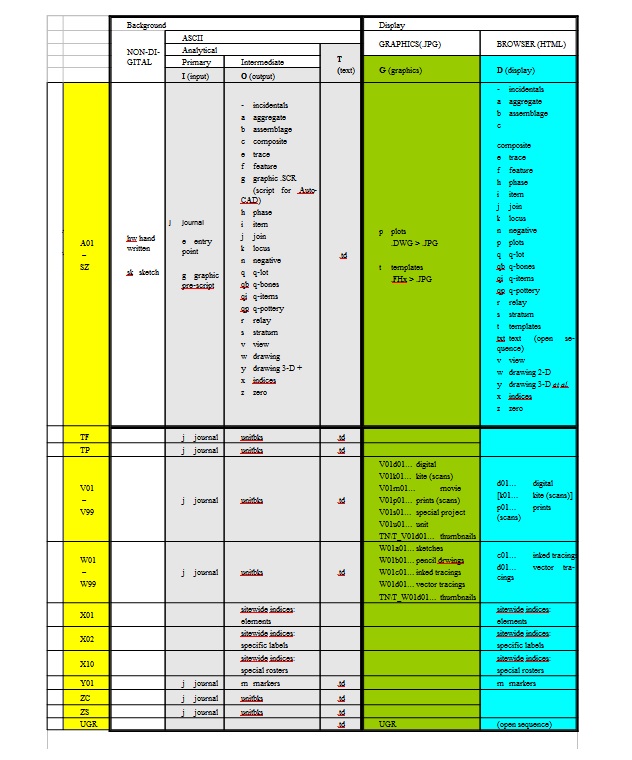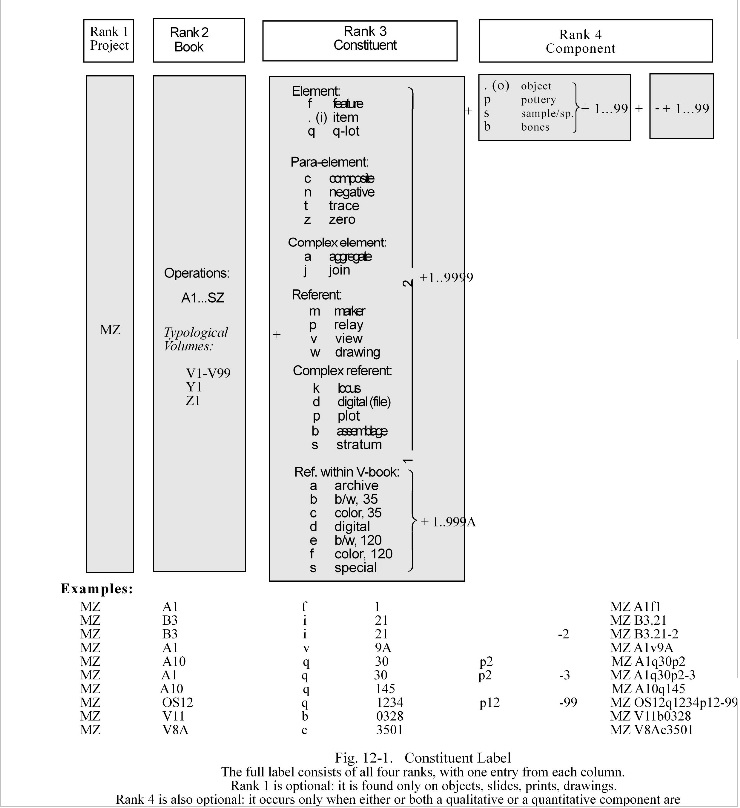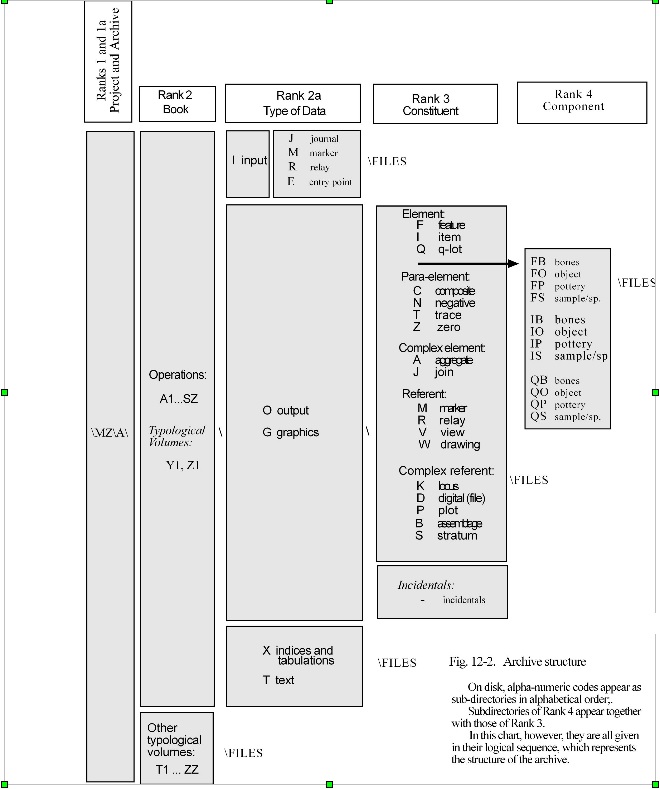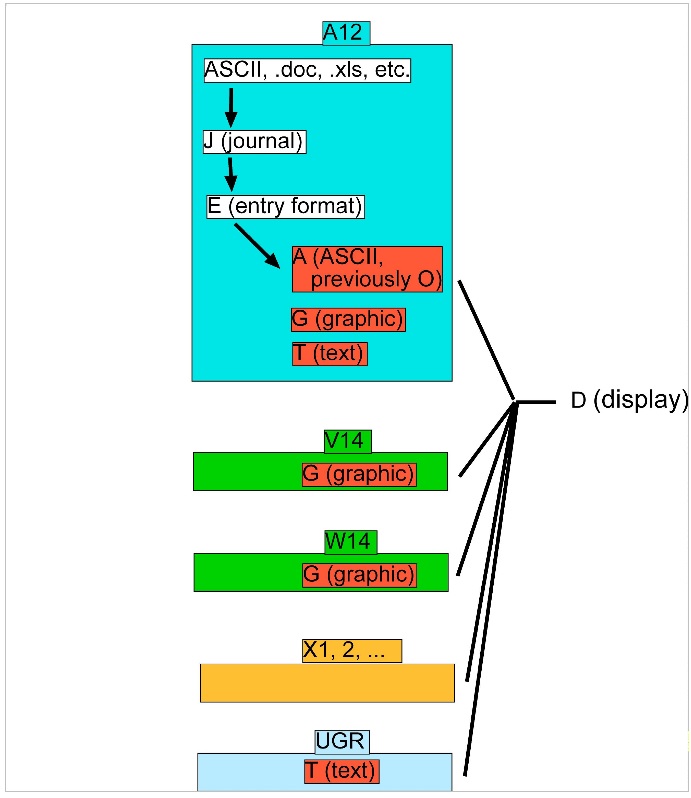Back to top: 32. Archive Structure
32.1: Correlation between labels and archive
There is a close correlation between … [missing ending to this sentence, ZGy20 mDP]
The labels (in their primary sense, i.e., the generic labels) define, at the same time, the structure of a major portion of the archive, since the subdivisions therein correspond exactly to the categories represented by the labels.
Because of this correlation, I will describe together, in this chapter, the structure of both the constituents and the archive. This correlation is highlighted in Figures 12-1 and 12-2 (section 32.9, bottom of this page), which present graphically and side by side the data discussed below.
Back to top: 32. Archive Structure
32.2: Archive structure: Directories
As indicated above (3.1), the structure of the archive mirrors that of the label (4). In other words, subdirectories and files correspond to the various segments of the label, as highlighted graphically the juxtaposition of charts 12-1 and 12-2 given below.
Thus, the same four ranks present in the directory tree that are found in the label structure, and in addition there are two sub-ranks (subsidiary ranks), labeled 1a and 2a, which reflect subdivisions of the respectively higher ranks 1 and 2 (see Fig. 12-3, bottom of this page).
As a result, there is a total of six ranks and sub-ranks, which function as subdirectories progressively nested within each other – except for ranks 3 and rank 4 which are listed sequentially. Files are found as appropriate within given directories depending on the nature of the directory.
The first rank is reserved for the site, which is placed directly within the root directory; for Mozan, this is \MZ.
Back to top: 32. Archive Structure
32.2.1: Rank 2a, for directories only: Type of data
The letters that follow in the alphabet are reserved for volumes that deal with the analysis of specific aspects of the record, as follows:
- T. – Typological analysis.
- V. – Visuals, i.e., photography.
- W. – draWings (both hand drawn and digital).
- X. – site wide indeXes now in MZ\A\MZ.
- Y. – surveYing.
- Z. – site overall.
Back to top: 32. Archive Structure
32.2.2: Part Two. Analysis Section A. Constituents
Besides the O sequence, other two letter labels are possible for rank 1, but only for directories, not for constituents, e.g., VW.
Volumes dealing with a type of analysis can also include numbers or letter characters, with a criterion similar to that used for topographic areas. A numeric code is used to indicate a purely sequential order: for example, Y1 stands for the marker log produced by the surveyor, and Z1 stands for the log of surface objects. An alphabetic code, on the other hand, stands for a subtype of analysis: for example, TC stands for ceramic analysis within typology, and ZS stands for storage lists.
Following is a sample list of codes used for subtypes of analysis (this is an open list, and codes may be added at will):
T = Typological
- TA – physical anthropology
- TB – paleo-botany
- TC – conservation
- TE – epigrapghy
- TF – figurines
- TG – glyptic
- TO – objects
- TP – pottery
- TZ – paleo-zoology
Z = Site general (procedural aspects)
- ZA – synopses (seasons, initials, etc.)
- ZC – conservation
- ZI – inventory
- ZP – site presentation
- ZR – region
- ZS – storage
- ZT – transfers
- ZSB – basic study collection
- ZSC – conservation collection
- ZSD – main display collection
- ZSN – natural science collection (seeds, soil)
- ZSP – basic study colletion
- ZSS – pottery library
- ZST – technical display collection
- ZSZ – zoology collection
Back to top: 32. Archive Structure
32.2.3: Constituent label and archive structure
ZT: transfers (lists of objects transferred to Museum, shipment of samples, etc.).
Notes on conservation (Qz09) potential indexable labels for wall conservation:
M
|
30
|
mudbrick walls –Palace
|
S
|
31
|
mudbrick walls– AA houses
|
U
|
40
|
stone architecture–Temple Terrace
|
X
|
50
|
sections
|
Z
|
|
|
The maximum range allowed for a numeric sequence is 2 digits, hence the maximum number allowed is 99.
For the Outer City, the 40 sequence is for foot survey transects (e.g., OD40), and the 50 sequence for units in cases where we are not sure of the units already declared (e.g., OD50).
In the case of V books (for photographs), the second part corresponds to the season, thus V10 stands for photographs taken during the 10th season.
Since study seasons are labeled with a letter suffix after the number of the previous excavation season, book labels for visuals are the only ones that may include a letter after a number, e.g., V10A for photographs taken during the study season 10A.
NB: for a file with all the old codes of seasons (until August 2022), see here; for the new codes (established September 2022, during the workshop “Beola 2“), see here.
Subcomponent reduced from 100 to A0, 112 to B2, etc.
To sum up, the book code may appear with a minimum of 2 characters and a maximum of 4, in one of the configurations shown below in Fig. 12-4, where the range of possible codes is also indicated, followed by some examples of acceptable book labels.
| Area |
Analysis |
| Zone |
Area |
Type |
Subtype |
|
sequence |
function |
|
sequence |
function |
A ... S
OA ... OS |
1 ... 99 |
A ... Z |
T ... Z |
1 ... 99 |
A ... Z |
Fig. 12-4: Structure of Rank 2: Book
Examples: Area Analysis
- two characters: A1, AK, TC, Z1
- three characters: A10, OH2, OHA, V8A
- four characters: OS12, V10A
Following is a list of all constituent codes in alphabetical order:
| Codes |
Normal constituents |
V book (digital) see separate file |
V book (pre-digital) |
| a |
aggregate |
archive |
|
| b |
assemblage |
|
black/white, 35 mm |
| c |
composite |
|
color, 35 mm |
| d |
|
digital |
|
| e |
trace |
extra (after ex-cav.) |
b/w, medium format |
| f |
feature |
|
color medium format |
| g |
graphic |
|
|
| h |
phase |
|
|
| i |
item |
infrared |
|
| j |
join |
|
|
| k |
locus |
kite |
|
| m |
marker |
|
|
| n |
neative |
|
|
| p |
plot |
print |
|
| q |
quantity lot |
|
- |
| r |
relay |
|
|
| s |
stratum |
scans |
|
| t |
trace |
|
|
| u |
|
unit photos |
|
v |
view |
|
|
w |
drawing, measured |
|
|
| y |
drawing, schemantic |
|
|
| x |
indices |
|
unclear or mixed strata |
| z |
zero |
|
|
The sub-rank 1a is the archive (abbreviated A). In the system configuration as presented here, this is the only category for rank 1a. The reason why this uniform label is not redundant is because there are other codes which are not discussed in this volume simply because they do not pertain to the topic of grammar. They include: F for financial, L for logistics and P for publications.
The second rank is for the book label, which is the same as discussed above (32.2). Thus, for instance, we would have \MZ\A\A1, \MZ\A\OS12 or \MZ\A\Z1.
The sub-rank 2a is for the type of data, of which there are five:
- I: Input
- O: Output
- G: Graphics
- T: Text
- X: indices and tabulations
Examples are: \MZ\A\A1\O, MZ\A\A1\T.
The third rank is for constituents, and the fourth for components. Constituent + component are found as subdirectories listed alphabetically after the pertinent component, as follows:
| F features |
I items |
Q q-lots |
| FB bones within features |
IB bones within items |
QB bones within q-lots |
| FO objects within features |
IO objects within items |
QO objects within q-lots |
| FP pottery within features |
IP pottery within items |
QP pottery within q-lots |
| FS samples within features |
IS samples within items |
QS samples within q-lots |
| V13\G\d13\V13d1364 … .TIF |
for large display |
| V13\G\ TN\T_V13d13\TN_V13d1364 ….JPG |
for thumbnails |
| V13\G\LoRes\L_V13d13\LR_V13d1364 ….JPG |
|
File structure of .A files
| A12i0108 |
|
|
|
| File produced on 08-08-2000 - Source File: A12\001.E - Standards: -F-A.001; -E-R.003 |
|
|
|
| B01 |
K720 |
ed |
cv |
| B10 |
K803 |
gg |
V13d1694 |
| O03 |
K724 |
gg |
V13d1636 |
| Item |
Label |
Directory |
File |
| A1q2-p |
(Ali2) |
|
individual |
| A1q2-p3 |
|
A1 \ O \ QP \ 0002 |
pottery lot |
| A1q2.3.4 |
|
A1 \ O \ QI \ 00020304 |
color medium format |
[last table to be reviewed, ZGy20 mDP]
Back to top: 32. Archive Structure
32.2.4: Constituent label and archive structure
| |
|
000203 |
within lot |
| A1q2-b3.1 |
|
A1 \ O \ QB \ 00020301 |
individual bone within bone group |
| A1q2-i |
|
A1 \ O \ QI \ 0002 |
item lot (may include pebbles, beads, wheel) |
| (A1q2-i3) |
A1q2.3 |
A1 \ O \ QI \ 000203 |
identified item lot (e.g., a bead lot) |
| (A1q2-i3.4) |
A1q2.3.4 |
A1 \ O \ QI \ 00020304 |
individual |
| A1q2-p |
|
A1 \ O \ QP \ 0002 |
pottery lot |
| A1q2-p3 |
A1q2.3.4 |
|
color medium format |
| A1q2-p3.4 |
|
A1 \ O \ QP \ 00020304 |
individual sherd within a sherd group |
Back to top: 32. Archive Structure
32.3: Archive Structure Files
The sequence of directories corresponds to each of the possible ranks and sub-ranks, so that file names consist exclusively of the sequential number of constituents and, where necessary, components. Files within V-books may have an optional letter character suffix.
To ensure a proper sequence with any type of directory listing, leading hyphens (-) are added in each case; hyphens are used instead of zeros because the label is thus more easily readable, as will appear from the examples that follow.
Constituents consist of a total of 4 digits, except for views (within a V-book), which consists of 3 digits plus an optional literal suffix. Leading zeros are used as needed to obtain the maximum of either 4 or 3 digits, e.g., —1 or -100 for all constituents except views, for which a maximum of three digits is found, e.g., –1 or -10 (with an optional suffix: –1A or -10B).
Components consist of two sets of two digits, the first corresponding to the typological, and the second to the sequential, subdivisions, respectively. These are appended to the immediate right of the constituent, resulting in a sequence of either 6 or 8 digits, e.g., —1-2 or —1-2-3.
If a typological component is missing, two hyphens are used to mark its place, e.g., —1—3.
The extension to the file name is given uniformly as .A, for “archive.”
Following is a list that correlates, by way of exemplification, a few constituent labels with their corresponding archive location:
| MZ A1f1 | MZ\A\A-1\O\F\---1.A |
| MZ A1f123 | MZ\A\A-1\O\F\-123.A |
| MZ B6v32 | MZ\A\B-6\O\V\-32.A |
| MZ B6v32A | MZ\A\B-6\O\V\-32A.A |
| MZ K1.3 | MZ\A\K-1\O\I\---3.A |
| MZ K1.3-1 | MZ\A\K-1\O\I\---3---1.A |
| MZ A10q8 | MZ\A\A10\O\Q\---8.A |
| MZ A10q8p9 | MZ\A\A10\O\QP\---8-9.A |
| MZ A10q8p9-7 | MZ\A\A10\O\QP\---8-9-7.A |
| MZ A10q8p19-27 | MZ\A\A10\O\QP\---81927.A |
Back to top: 32. Archive Structure
32.4: V/W directory/file names
Back to top: 32. Archive Structure
Labels for VW files (R713)
To be considered (P117)
W17t0102 A16c4~611 P117 mKB
W17t1412 A16.134.12~611 P117 mKB
W17t1412 A16q921.2.1~611 P117 mKB
Back to top: 32. Archive Structure
Directories
V14 or W14 (or the like)
| A |
Archive |
notes and journal files; journal files include V files for assemblages, see e.g., under V17 or V23 |
| D |
Display |
html file with reference to .jpg files in G directory |
| G |
HiRes |
high resolution |
Back to top: 32. Archive Structure
32.4.1: Constituent label and archive structure
Back to top: 32. Archive Structure
32.4.1.1: Photos (V)
| V00 |
lower case letter in the 00 series is free, thus, g stands for glytic |
| V14d01_A9v |
dummy folders, used only to define content; identified by underscore; it contains no files and has no length limits |
| V15e46 |
more digital folders for excavation photos, including additions to work done during season - must have 6 - characters each book has a different folder in order to allow for easy storage on unit DVD |
| V15f46 |
ditto |
| V15g46 |
ditto |
| V15h46 |
ditto |
| V15i46 |
incidentals |
| V15k46 |
k: kite pictures- also gp |
| V15m46 |
m: movie clips |
| V15n46 |
n: scans from negatives - matches the b numbers |
| V14p01 |
p: scans from prints and color slides - matches the c numbers
p: also pilot shots |
| V20q01 |
q: scans of shred sections |
| V14s01 |
s: photos for storage (equivalent to u) |
| W15t46 |
t: details of drawings, e.g. special roster elements - must have 6 characters |
| V15u01 |
u: unit photos (not taken by photographer) |
| V15v01 |
v: views within V-book (assemblages) |
| V15w01 |
w: work in winter (Kamiran, Diadin) |
| V15x01 |
x: conservation |
| V15y01 |
y: site preservation |
| LoRes |
low resolution |
| W15d46 |
must have 6 characters |
Back to top: 32. Archive Structure
32.4.1.2: Drawings (W)
| V14a01 |
sketches |
| V14b01 |
pencil drawings |
| V14c01 |
pen drawings |
| V14d01 |
vector drawings |
Back to top: 32. Archive Structure
32.4.2: Part Two. Analysis Section A. Constituents
| TN |
thumbnails |
| V14d01 |
must have 6 characters |
| T |
text files, including archival lists of slides |
| V80 |
items photographed after excavation |
| V80d16 |
A16 (cumularive for all years of excavation) |
| V80d51 |
J1 |
| V80e05 |
A16 after V80d99 is reached |
| V90 |
ceramics
special series (e.g., incised sherds) ~ VW99. but buy photographic registrar, and more in the styles of assemblages: individual items or views assembled for typological reasons |
V95 (U825)
V95x01 |
wall conservation - Palace sector A |
| V95x02 |
wall conservation - Palace sector B |
| V95x03 |
wall conservation - Palace sector C |
| |
V20x0308 X12v21 R723 bML 2007
V21x0308 X12v21 S720 cL 2008
V22x0308 Z11v21 T727 gW C5
V23x0308 AP^wfC5-3 U822 eD |
| V99 |
site general (for photos taken during regular seasons, etc.) |
| 1 |
2 |
3 |
4 |
5 |
6 |
7 |
| VW label |
VI- label |
date |
init. |
df |
notes |
ext. |
| V14d0010 |
A9v60a |
L705 |
jff |
- |
bright |
jpg,tif.FHx |
| V14d0016 |
-wa_A9_dirt_removal |
L707 |
jff |
|
|
jpg,tif.FHx |
| V14d0503 |
A9.98 |
L716 |
gg |
ma |
zc_at |
jpg,tif.FHx |
| V14d0532 |
A9.149 |
L722 |
gg |
|
zc_at |
jpg,tif.FHx |
| V14d0550 |
A9.138 |
Lx04 |
gb |
si |
modern rolling |
jpg,tif.FHx |
| V14d0016 |
-wa |
L707 |
jff |
|
|
jpg,tif.FHx |
| V14d0016 |
-wa_A9_dirt_removal |
L707 |
jff |
|
|
-- |
| V14d0016 |
-sf_gb-mkb |
L707 |
jff |
|
|
-- |
| V23x0301 |
AP^C5-7 |
U822 |
eD |
|
|
|
| V23x0302 |
AP^C5-7a |
U822 |
eD |
|
detail of crack |
|
| V17p2401 |
A9v169 |
O714 |
gg |
|
V17c0426 |
|
| L_W15d460 |
A16c1 |
M |
f |
s |
|
jpg |
| 1 |
|
928 |
lp |
i |
|
jpg |
| L_W15d4601 |
A16c1 |
M928 |
flp |
si |
|
|
| L_W17t1602 |
A16i0108~611 |
- |
- |
- |
L_W15d4611 A16.0108 M924 fk2 si f0294 |
jpg |
| L_W15t4603 |
A16i0108~612 |
- |
- |
- |
L_W15d4611 A16.0108 M924 fk2 si f0294 |
jpg |
| T_V14d0010 |
A9v60a |
L705 |
jff |
- |
- |
jpg |
Back to top: 32. Archive Structure
Notes
- fields 2-5: if a field is missing, enter hyphen (not needed for 5 and 6);
- field 2: no spaces allowed, do not use leading zeroes
with incidentals, there must always be a code consisting of hyphen and two characters
either by itself, or followed by underscore and additional info (with each word separated by underscore):
- field 6: no underscore needed: all words in this field are considered within the field
underscore can be used to link segments
abbreviations: bt (before treatment)
at (after treatment)
nb (photo with number included)
period is illegal in this field, as it introduces the extension
underscore may be used to separate subdivisions within field, e.g. zc_at for conservation after treatment
fixed format for W17t type files: this field must include the full label of the graphic file for the entire drawing.
Back to top: 32. Archive Structure
32.4.3: Constituent label and archive structure
Field 7: — extension used for dummy files, i.e. files that are empty and give crossreferences in label.
Cf. below, Fig. 13-3 (“Structure of directory and file labels for VW books”).
For W files:
W14db1612 A10q218-p4 L901 xxx cv.jpg
change to
W14b1612 A10q218-p4 L901 xxx cv @W14d1638.jpg
For VDM type label for directories:
VDM922 2139 gg A12 night
change to
^VDM922 2139 gg A12 night
when transferred to V15
For files:
VDM922 2139 gg 9499.JPG
change to
VDM922 2139 gg 9499 @V15d2085.JPG
when transferred to V15 (no caret)
For conservation photos:
| V15x01 | monitoring of individual walls |
| V15x50 | activities |
| V15x60 | coverings and floors |
| V15x70 | monitoring mechanisms |
| V15x80 | deterioration |
| V15x90 | post-excavation history |
| |
date |
initials |
time |
subject |
| initial roll |
VDO628 |
flp |
1620 |
ZSB12 beads |
| after transfer to V17s |
^VDO628 |
etc. |
|
|
| |
date |
initials |
time |
seq number |
item number |
V17 number |
| indiv.frame |
VDO628 |
flp |
1620 |
6721 |
A10q78-1 |
@V17s1201 |
| roll |
V17s12 |
|
| dummy |
V17s12 beads |
empty folder |
| roll |
|
|
| |
photo number |
item number |
date |
initials |
type |
comment |
| indiv. frame |
V17s1201 |
A10q78-1 |
O628 |
flp |
bd |
frit, oblong, complete |
| |
no spaces allowed in these 5 fields |
spaces allowed |
Note: shaded areas are obligatory.
Back to top: 32. Archive Structure
32.5: Labels for ZC referents (T725)
Directories:
| r | room (Z11rA1) |
| v | view (V11x) |
| w | wall |
For conservation photos:
| V15x01 | monitoring of individual walls |
| V15x49 | |
Back to top: 32. Archive Structure
32.5.1: Part Two. Analysis-Section A. Constituents
| V15x50 | activities |
| V15x60 | coverings and floors |
| V15x70 | monitoring mechanisms |
| V15x80 | deterioration |
| V15x90 | post-excavation history |
| V21x0201 X05v49 S720 cL 2008 B1north.JPG | [old X format] |
| V22x0201 Z11v49 S720 cL Z11rB1-north.JPG | by room |
| V21x0316 Z11v68 S721 cL Z11rC1-east.JPG | [old format, view number out of sequence, Z11rC1 allows sorting by room] |
Back to top: 32. Archive Structure
32.6: Special books
Special books My16:
| V13a | archive |
| V13d | digital |
| V99 | replaces VG for general |
W13w
W13a
W13p
W13b
W13t | drawings (or)
pencil (or)
preliminary (or)
traced (or)
traced, inked |
| X13p | plates |
| X13t | thumbnails moved to VW13 |
Back to top: 32. Archive Structure
32.6.1: Constituent label and archive structure
[TEXT MISSING, ZGy20 mDP]
Back to top: 32. Archive Structure
32.7: Summary

Fig. 13-3: Directory structure for individual Units (O320 based on Mx04).
Note: Italics (on white background) refer to categories not present in digital archive.
Back to top: 32. Archive Structure
32.8: Incidentals
As indicated, incidentals approximate the status of constituents, even though they are structurally quite distinct. One major difference is that there is no sequential numbering of incidentals. Accordingly there is, properly speaking, no real label for incidentals, even if one may use “A1-sg” to refer to a discussion about strategy within A1. In point of fact, such a form of labeling is used within the archive, where observations about overall strategy will be found, sorted chronologically, within a directory \MZ\A\O-\SG.
The codes used to denote incidentals belong, as I have stressed (see section 2.2) to an open system, and are listed lexically in section 7.5.4.
Back to top: 32. Archive Structure

Fig. 12-1: Constituents Labels.

Fig. 12-2: Archive Structure.

Fig. 12-3: Subdivision between ranks 1 and 2.
Back to top: 32. Archive Structure